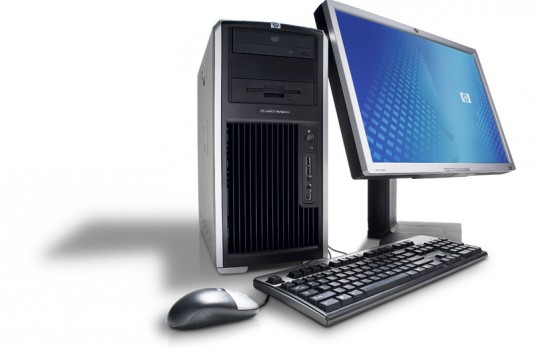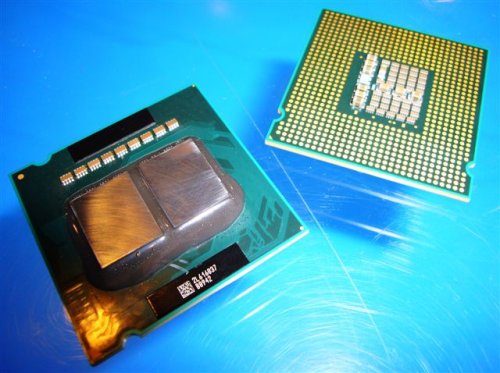The 2007 launch of HP workstations using Intel quad core CPUs was a milestone for technical graphics. Processes that previously took days on PC workstations now took hours or minutes. From the February 2007 edition of Engineering Automation Report, acquired in 2010 by Jon Peddie Research.
By Randall S. Newton
“Hello, high-end computing, the quad-cores are here! November 14, 2007 will be a red-letter date in the history of x86 computing.” — Geek.com
Engineering Automation Report, February 2007—I landed in Denver Sunday afternoon for the HP/Intel Quad Fest worrying about my feet. I should have been worried because I was wearing Crocs (wonderfully comfortable but summery shoes from a company in nearby Boulder) and they aren’t really appropriate for 35 degrees and 30 mph wind. But the reason I worried for my feet was more metaphoric in nature.

The previous EIC of this newsletter, David Cohn, always did a bang-up job writing about hardware. (So good, in fact that he’s still doing it part-time for Desktop Engineering magazine.) So I’m attending my first workstation launch in nine years knowing I have big shoes to fill, and I am wondering if my feet are up to the task. I’ve written my fair share of computer hardware reviews over the years, but I’ve never made it an area of expertise the way David has. He can spout off the arcane product names and their place in the CPU generations as if they were his children, and recite their SPEC benchmark scores like some men recite batting averages. By comparison, I know I like my computers with lots of RAM and a fast video card. Except now we are supposed to call video cards Graphics Processing Units, whatever that means.
The HP/Intel QuadFest started with an introduction to the new products from grandfatherly Chris Christopher, a senior VP at HP who, I am told, keeps getting more and more business units moved under his watch. It seems new CEO Mark Hurd is not only a good cost-cutter, but a talent scout as well. In a soft Greek accent, Christopher pointed out that workstation customers really do need more than the typical desktop computer. Workstation customers are distinctive because their primary applications are not simply important, they are mission-critical. They are often early adopters whose need for speed is not wrapped up in geek machismo but in profits and productivity. “Fifteen years ago people were saying, ‘who needs workstations?’” said Christopher. “But here we are with customers still demanding workstations. The problems [requiring workstations] are getting bigger and bigger.”
Christopher listed four key customer segments for workstations: manufacturing design and analysis, digital content creation, oil/gas exploration and development, and financial analysis and trading. Each of these fields is ready to throw computation horsepower at key tasks as soon as there is a new upward bend in the price/performance curve. As I soon discover, Quad Core doesn’t offer a bend in the curve, it offers a hockey stick.
As Christopher talks, I am wondering if all this talk of innovation, value proposition and paradigm shift is just so much hot air despite his gentle demeanor. I remember the last workstation product launch I attended, a razzle-dazzle event at the Tech Museum of Innovation in San Jose, California. Silicon Graphics (SGI) was introducing its first Windows-compatible, industry-standard workstation. One problem—SGI seemed to think the words “compatible” and “standard” were open to interpretation. Their workstations required a custom version of Windows, they used proprietary graphics boards, and they only supported SGI’s high-priced monitors. The product line was a washout.
But HP is no SGI, I remind myself. They have been an innovator and a leading manufacturer of Windows workstations for several years. According to IDC, they are taking market share away from Dell and IBM. Workstation sales over the last four quarters show HP up 27% while Dell is up 8% and IBM is up 14%. The market as a whole is up 16%, so HP sales are growing faster than the competition. The numbers for the installed base of workstations (also from IDC) are interesting: Dell has 49% of the market, but their share is falling; IBM has 6% of the market and their share is falling; HP has 35% of the market and their share is rising.
The Intel guy is up next. Tom Kilroy is co-general manager of Intel’s Digital Enterprise Group, and he wants us to know that Intel the Innovator is back. “We are moving power to the knowledge worker,” with the new Quad Core CPU, he says. Model complexity is increasing, the move from 2D to 3D is accelerating, and the trend to move processing from the back-end server to the client is in high gear. Quad Core technology doesn’t just respond to these trends, Kilroy says, it drives the trend.
The Quad Core technical specifics are impressive. This week Intel is shipping two new Quad Core CPUs, the Xeon 5300 series and the Core 2 Extreme QX6700; HP is shipping workstations using both. Intel began the transition to multi-core technology (multiple CPUs working as a unit) four years ago with Hyper-Threading Technology, followed by the introduction of the industry’s first dual-core PC processors April 2005. Intel recently refreshed its entire product line by introducing over 40 new processors, including those based on the new Intel Core Microarchitecture, which it claims is a more powerful yet energy-efficient CPU design.

Coming into this meeting, I was aware that few mainstream CAD/CAM/CAE developers have modified their software to take specific advantage of multiple CPUs. The obvious question for readers is, “Will Quad Core make a difference in my workflow?” To answer that question, HP and Intel brought in specialists from four disciplines: Landmark Software for oil/gas exploration; PTC for manufacturing design and engineering; ANSYS for manufacturing analysis; and Autodesk for digital content creation. There were three sessions available, so I attended all except digital content creation. DCC guys are all the same—loaded on caffeine and bugged-eyed about rendering polygons to make anatomically impossible animation characters. I didn’t need to visit them.
The guys from Landmark were assigned the Geek Dream hardware set-up; four widescreen monitors in a square array displaying a single image. The quad-monitor setup was powered by HP’s top-of-the-line xw8400. It was equipped with two Xeon Quad Cores, giving it eight CPUs. The rated speed of each CPU is 2.8 GHz. To one side sat an HP xw8200, a previous-generation workstation running two Intel Xeon Pentium 4 CPUs at 3.8 GHz. The test model was a British Petroleum oil field in the UK that has the unfortunate luck of being under a popular and pristine beach. They ran two tests side by side on the two machines, basically calculating volumetric geologic attributes, including fault discontinuities, from sound waves. One dataset was 588 megabytes, the other 30 gigabytes. The Quad Core finished the first test in about two minutes; the older workstation was 25% finished. The second test was about using the data interactively. It was possible to move the model in real time and display specific attributes on the fly only with the Quad Core workstation.
Many data sets available to oil and gas exploration are underutilized because it takes too long to process the data, the Landmark guys explained. The first use of a Quad Core workstation on a potential oil or gas field could make it possible to avoid drilling dry holes, saving millions. The industry rule of thumb is that one exploration engineer or analyst costs $450 per hour. Landmark calculates that companies using their current software on a new HP Quad Core xw8400 could see up to a 65x improvement in processing workflow, factoring in the value of faster interpretation of data and the more complete use of datasets.
The mention of “workflow improvement” echoed through the rest of my sessions. Eric Miller is CAD director and a principal of PADT, an engineering consulting firm that uses ANSYS and Fluent software. He didn’t spare the superlatives as he demonstrated various analysis scenarios. Using Quad Core workstations will make it possible to simulate earlier—with complex physics—in the design cycle. Yesterday, Miller said, we needed servers and clusters to do high-performance computing for analysis; today we can do the same thing with desktop workstations. In his tests ANSYS solution performance was 2.5 times faster on a Quad Core than on a Pentium-class workstation, and Fluent test performance was 2.5x-3x better. “Our typical job [using Fluent] runs one week; we now run them two to three-times faster.” Miller says using Quad Core workstations gives his company 15% more engineering time, and will reduce the need for one or two lab tests per year at $120,000 each. “The Quad Core solved one analysis in a day that we couldn’t run in our older machines.”
My last session was with PTC. They brought in Dr. Andreas Vlahinos, a respected independent researcher on the use of CAD in manufacturing engineering. “Finally we have desktop hardware that enables simulation-driven design,” Vlahinos said. “It is great to get immediate feedback on key performance attributes with every design interaction.” Vlahinos said the use of Quad Core workstations in engineering opens the door to “performance-centric, not geometric-centric” engineering. An analysis for 2.5 million degrees of freedom that took two hours to run on a single Pentium-class CPU was solved in four minutes on the HP xw4400, the entry-level Quad Core workstation.
“Benchmarking disappears,” noted HP’s Tom Salamone, who was marketing workstations for Digital before it was bought by Compaq before it was bought by HP (he’s a survivor). The real issue is workflow change, Salamone argues, making it possible to do things an engineer on a workstation couldn’t do before. Such new capability is as big a shift for the engineering market as the introduction of Windows NT, he claims. It is about the economics of desktop engineering and the nature of workflow enabled by the technology. Dr. V agreed: “The limit now is the software.” Running tests using all eight cores (two Quad Core Xeons), Vlahinos said CPU usage never hit 90%. “We can now tailor tools to the design process, not vice versa.” Using Quad Core means an engineer can successfully multi-task, he noted. Opening Outlook and Excel while running an analysis is now not only possible but stress-free.
I left the day’s event with my head spinning, but HP and Intel weren’t finished. For the evening, we visited the Gates Planetarium, where an incredible star show is generated in real-time using three new HP xw8400 Quad Core workstations. They replaced a bank of four SGI servers, each the size of a refrigerator.
I’m on the list for a review unit. I can hardly wait.





